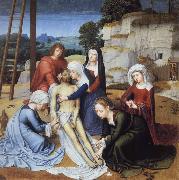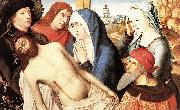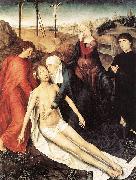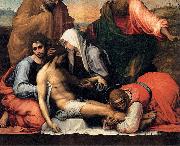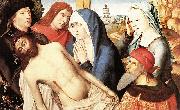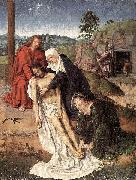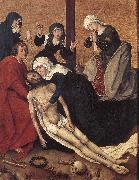Wholesale Oil Painting Reproductions No Minimum and Door to Door! |
|||||||||||
|
|
|||||||||||

|
|||||||||||
|
|
|
||||||||
All Gerard David Oil Paintings |
||||||||
|
|
||||||||
|
|
||||||||
|
Artist Introduction: b.c. 1460, Oudewater, Neth.
d.Aug. 13, 1523, Bruges
Flemish Gerard David Locations
Netherlandish painter. He is known as the last of the Flemish Primitives. Although born in the northern Netherlands, he moved to Bruges as a young man, and most of his work expresses the impassive, unmannered, microscopically realistic approach peculiar to south Netherlandish art in the time of Jan van Eyck. David was skilled at synthesizing the art of several important south Netherlandish predecessors, adapting, for instance, the compositions of van Eyck and the technique of Hugo van der Goes. He was also influenced by Hans Memling, whose example led him to refine and polish his cruder northern Netherlandish style and to adopt the popular theme of the Virgin and Child enthroned. |
||||||||
|
|
||||||||
|
Lamentation Painting ID:: 42928 |
mk170
1515-1520
Oil on oak
63x62.1cm
|
|||||||
Height Width |
INS/CM Quality |
|||||||
|
X |
| |||||||
|
|
||||||||
All Master of the Legend of St. Lucy Oil Paintings |
||||||||
|
|
||||||||
|
|
||||||||
|
Artist Introduction: (fl. 1480-1510) was an unidentified Early Netherlandish painter who worked in Bruges, now a city in Belgium. His name comes from for an altarpiece in the church of Saint James in Bruges, which is dated 1480 and depicts three scenes from the life of Saint Lucy. Since then, twenty-five to thirty-five paintings have been attributed to the same hand. He may have trained Spanish students at his studio in Bruges. Many of them are characterized by views of the city of Bruges in the background, and can be dated according to the level of construction of its belfry. He may have trained with Dieric Bouts, and was certainly influenced by Bruges' greatest artist at the time, Hans Memling.
|
||||||||
|
|
||||||||
|
|
Lamentation Painting ID:: 85899 |
Date 1490s
Medium Oil on oak panel
Dimensions Height: 81.2 cm (32 in). Width: 123.3 cm (48.5 in).
cjr |
||||||
Height Width |
INS/CM Quality |
|||||||
|
X |
| |||||||
|
|
||||||||
All Hans Memling Oil Paintings |
||||||||
|
|
||||||||
|
|
||||||||
|
Artist Introduction: Netherlandish Northern Renaissance Painter, ca.1435-1494
Born in Seligenstadt, near Frankfurt in the Middle Rhein region, it is believed that Memling served his apprenticeship at Mainz or Cologne, and later worked in the Netherlands under Rogier van der Weyden (c. 1455?C1460). He then went to Bruges around 1465.
There is an apocryphical story that he was a wounded at the Battle of Nancy, sheltered and cured by the Hospitallers at Bruges, and that to show his gratitude he refused payment for a picture he had painted for them. Memling did indeed paint for the Hospitallers, but he painted several pictures for them, in 1479 and 1480, and it is likely that he was known to his patrons of St John, prior to the Battle of Nancy.
Memling is connected with military operations only in a distant sense. His name appears on a list of subscribers to the loan which was raised by Maximilian I of Austria, to defend against hostilities towards France in 1480. In 1477, when he was incorrectly claimed to have been killed, he was under contract to create an altarpiece for the gild-chapel of the booksellers of Bruges. This altarpiece, under the name of the Seven Griefs of Mary, is now in the Gallery of Turin. It is one of the fine creations of his more mature period. It is not inferior in any way to those of 1479 in the hospital of St. John, which for their part are hardly less interesting as illustrative of the master's power than The Last Judgment which can be found since the 1470s in the St. Mary's Church, Gda??sk. Critical opinion has been unanimous in assigning this altarpiece to Memling. This affirms that Memling was a resident and a skilled artist at Bruges in 1473; for the Last Judgment was undoubtedly painted and sold to a merchant at Bruges, who shipped it there on board of a vessel bound to the Mediterranean, which was captured by Danzig privateer Paul Beneke in that very year. This purchase of his pictures by an agent of the Medici demonstrates that he had a considerable reputation. |
||||||||
|
|
||||||||
|
|
Lamentation Painting ID:: 86357 |
Date between 1475(1475) and 1480(1480)
Medium Oil on oak panel
cjr |
||||||
Height Width |
INS/CM Quality |
|||||||
|
X |
| |||||||
|
|
||||||||
All Fra Bartolomeo Oil Paintings |
||||||||
|
|
||||||||
|
|
||||||||
|
Artist Introduction: Italian High Renaissance Painter, 1472-1517, also known as Baccio della Porta, was an Italian Renaissance painter of religious subjects. He was born in Savignano di Prato, Tuscany. He received the nickname of Baccio della Porta for his house was near the Porta ("Gate") San Pier Gattolini. Starting from 1483 or 1484, by recommendation of Benedetto da Maiano, he apprenticed in the workshop of Cosimo Rosselli. In 1490 or 1491 he began a collaboration with Mariotto Albertinelli. In the late 1490s Baccio was drawn to the teachings of Fra Girolamo Savonarola, who denounced what he viewed as vain and corrupt contemporary art. Savonarola argued for art serving as a direct visual illustration of the Bible to educate those unable to read the book. From 1498 is his famous portrait of Savonarola, now in the Museo Nazionale di San Marco in Florence. The following year he was commissioned a fresco of the Universal Judgement for the Ospedale di Santa Maria Nuova, completed by Albertinelli and Giuliano Bugiardini when Baccio became a Dominican friar on July 26, 1500. The following year he entered the convent of San Marco. He renounced painting for several years, not resuming until 1504 when he became the head of the monastery workshop in obedience to his superior. In that year he began a Vision of St. Bernard for Bernardo Bianco's family chapel in the Badia Fiorentina, finished in 1507. |
||||||||
|
|
||||||||
|
|
Lamentation Painting ID:: 89292 |
between 1511(1511) and 1512(1512)
Medium oil on wood
cyf |
||||||
Height Width |
INS/CM Quality |
|||||||
|
X |
| |||||||
|
|
||||||||
All Master of the Legend of St. Lucy Oil Paintings |
||||||||
|
|
||||||||
|
|
||||||||
|
Artist Introduction: (fl. 1480-1510) was an unidentified Early Netherlandish painter who worked in Bruges, now a city in Belgium. His name comes from for an altarpiece in the church of Saint James in Bruges, which is dated 1480 and depicts three scenes from the life of Saint Lucy. Since then, twenty-five to thirty-five paintings have been attributed to the same hand. He may have trained Spanish students at his studio in Bruges. Many of them are characterized by views of the city of Bruges in the background, and can be dated according to the level of construction of its belfry. He may have trained with Dieric Bouts, and was certainly influenced by Bruges' greatest artist at the time, Hans Memling.
|
||||||||
|
|
||||||||
|
|
Lamentation Painting ID:: 90050 |
1490s
Medium oil on oak panel
Dimensions Height: 81.2 cm (32 in). Width: 123.3 cm (48.5 in).
cyf |
||||||
Height Width |
INS/CM Quality |
|||||||
|
X |
| |||||||
|
|
||||||||
All Gerard David Oil Paintings |
||||||||
|
|
||||||||
|
|
||||||||
|
Artist Introduction: b.c. 1460, Oudewater, Neth.
d.Aug. 13, 1523, Bruges
Flemish Gerard David Locations
Netherlandish painter. He is known as the last of the Flemish Primitives. Although born in the northern Netherlands, he moved to Bruges as a young man, and most of his work expresses the impassive, unmannered, microscopically realistic approach peculiar to south Netherlandish art in the time of Jan van Eyck. David was skilled at synthesizing the art of several important south Netherlandish predecessors, adapting, for instance, the compositions of van Eyck and the technique of Hugo van der Goes. He was also influenced by Hans Memling, whose example led him to refine and polish his cruder northern Netherlandish style and to adopt the popular theme of the Virgin and Child enthroned. |
||||||||
|
|
||||||||
|
|
Lamentation Painting ID:: 91004 |
first half of 16th century
Medium oil on oak panel
Dimensions Height: 39.4 cm (15.5 in). Width: 31.7 cm (12.5 in).
cyf |
||||||
Height Width |
INS/CM Quality |
|||||||
|
X |
| |||||||
|
|
||||||||
All Vrancke van der Stockt Oil Paintings |
||||||||
|
|
||||||||
|
|
||||||||
|
Artist Introduction: painted Triptic del Judici Final. Visio tancada del triptic in 1460
|
||||||||
|
|
||||||||
|
|
Lamentation Painting ID:: 98303 |
second half of 15th century
Medium oil on panel
cyf |
||||||
Height Width |
INS/CM Quality |
|||||||
|
X |
| |||||||
|
|
||||||||
|
Prev Next
|
||||||||
|
|
||||||||
|
Related Paintings to Vrancke van der Stockt :. |
||||||||
|
|
||||||||
|
CONTACT US |
